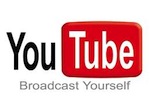 Scoring lots of video views on YouTube is only useful to you if you can get your audience to take an action step once they’re on your channel and enjoying your videos. So how can you increase the chances they’ll make their way over to your main website, blog, or other online content?
Scoring lots of video views on YouTube is only useful to you if you can get your audience to take an action step once they’re on your channel and enjoying your videos. So how can you increase the chances they’ll make their way over to your main website, blog, or other online content?
1. Insert your website domain into your videos using video editing software. Remember that the sharing mechanisms on YouTube might lead to your video being embedded elsewhere online, such as in a forum or on someone else’s blog. Since those off-site viewers won’t have immediate access to your YouTube channel or a video’s title and description, you want to be sure your main website domain appears at the beginning, middle, and end of your video.
Consider adding it via a watermark so it’s always visible (just don’t obstruct the view). You can always outsource such video editing tasks, or take a stab at using the free video editing software that should have come installed on your computer: Windows Movie Maker for PCs or iMovie for Macs. More expensive video editing programs are also available, such as Pinnacle, Final Cut, and Premiere.
2. Get your website domain into your videos using the YouTube Annotations tool. If you don’t have time or money to delve into video editing, your domain can be added to the beginning, middle, and end of your videos using YouTube Annotations—a way to add interactive commentary onto your videos from within the YouTube interface (and without having to use any video editing software of your own). Add such annotations after your video is uploaded. You control what the annotations say, where they appear on the video, and when they appear and disappear. You can even create a live link from an annotation to another YouTube video, channel, or search result. Annotations will also show up on YouTube videos embedded elsewhere, off of the YouTube site.
3. Ask and You Shall Receive. As I mentioned earlier, it never hurts to ask your audience to do what you want them to do. My “Ask and You Shall Receive” rule goes beyond simply flashing your website domain on the screen. Say it out loud several times, and for goodness sake, tell us what all we’ll find when we get there. “Visit my website at www.xyz.com because I’ll give you (more information, a free report, a downloadable coupon).” Or just drop hints to tempt us to go there.
4. Hyperlink your website URL as the first item in your video description. Why first, you ask? So it will always be visible, even if visitors don’t click on the “more info” link on the description that accompanies it. You also want to signal to prospects that this video wasn’t made by some hobbyist, but by a professional with a full online presence.
5. Treat the description area of your YouTube channel like it’s a mini sales letter. Start by telling your audience about you and your level of expertise within your niche area. Be sure to also discuss some of the benefits people will gain if they venture over to your main website. Don’t forget your URL, not only in the spot YouTube designates for you to do so, but also in your channel description.
6. Bribery often works. Within your video offer something free, include a cliffhanger, or hold a contest. For viewers to take advantage of your offer or have their curiosity satisfied make them head over to your main website. Meanwhile, think of ways to offer extra value to your audience, and they’ll become loyal fans who promote your videos for you.
7. Call-To-Action Overlay ads. These are semi-transparent pop-up overlays that link viewers to any third-party website you choose. For example, you could run an overlay on your own video inviting YouTube viewers to click and sail right through to the corresponding website you’re promoting. This is incredibly handy for generating engaged, well-targeted traffic to your website.
(The following post is excerpted from YouTube Expert, Julie Perry’s chapter in Success Secrets Of The Social Media Marketing Superstars).